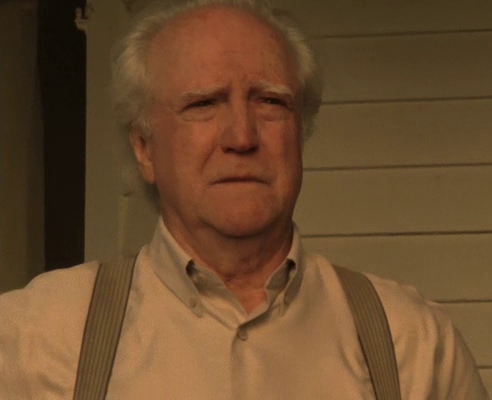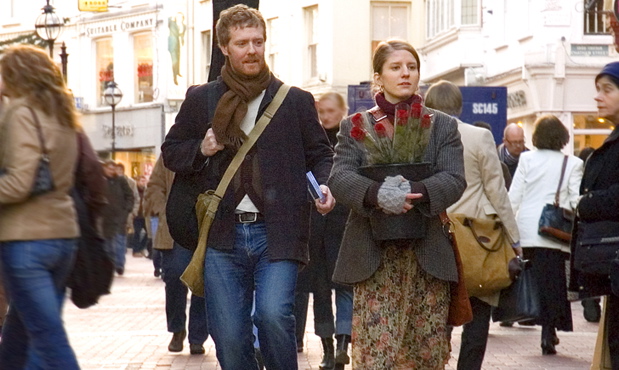Those who wish to heal, find, and share themselves must step
outside of the boundaries set by society and create themselves through
revelations and the utilization of resources that surround them.
Seven Pounds
In Seven Pounds, Ben Thomas is face with a daunting internal guilt. He
feels that he owes a debt to society and must give himself to redeem himself.
He helps to save seven people’s lives to replace the seven he killed.
Throughout the story he must struggle through his painful memories and his love
for Emily Posa. To redeem himself Thomas gives parts of his body to people in
need but first he makes sure the people he donates to are good hearted. “He’s
punishing you. How is he punishing you?” (Seven
Pounds). Thomas probably doesn’t think of himself as a righteous man and he
doesn’t believe he deserved to survive the accident. Now he is making sure that
the people he’s donating to are deserving of his gift. Thomas is helping other
people because he believes it is literally impossible to fix his. “In seven
days, God created the world. And in seven seconds, I shattered mine” (Seven Pounds). Thomas had a perfect life
until the car accident. After that, he lost everything and is forced into a
life of guilt. Because he can’t fix his own life, he decides to improve other
people’s lives. “I haven’t felt like this in a really long time” (Seven Pounds). Thomas brings life to
Posa and shares a feeling with her because they’ve both gone through a lot. He
improves her life not only emotionally but physically as well when he gives his
life to save Posa with a heart transplant. Even in a time of deep depression,
Thomas is able to find empathy for his society because he feels responsible for
his actions. Thomas does want to heal his metaphorical wounds from the car
accident. He can only do this by healing others and filling up the hole he dug
when the accident happened.
PressPausePlay
In PressPausePlay, new technology is proven
to allow more people to have access to music and artistic creation. The new
technology lets users easily create, publish, and share art. This lets the
artists have a false sense of impact on society because they can share anything
on the internet. They believe they can make a change on current culture with
their art. "Slap up their early stuff on Facebook. On YouTube. It would
get lost. It would get lost in the ocean of garbage" (PressPausePlay). As Keen describes, there is so much information on
the internet that an artist’s chance of becoming noticed becomes extremely
slim. The reason so many people swarm the internet with their art is because of
new technology. Talent isn’t even a necessity when creating music anymore. “A
big difference is that around that time you had to be around 30, 35, know
people, and have a little bit of money to be able to record stuff” (PressPausePlay). Robyn elaborates on how
in older times the artist created themselves whereas now people can easily buy
their own recording equipment and make songs electronically without any musical
theory or talent. There are few exceptions of artists who become famous or
successful with such an overflow of other artists. Olafur Arnalds is an artist
who became known through technology. He electronically creates classical music
with computer software. “It was not some years of preparation. It was just a
few months” (PressPausePlay). Arnalds
explains how he quickly became famous without much musical knowledge and how
simple technology had made it for him to spread his work. In rare cases,
internet sensations may become famous. Most of the time, good artists are self-created
and work to get where they are without the help of too much technology. Putting
art on the internet makes it lose its special properties and becomes engulfed
by other artist’s work. An artist on the internet is the same as a grain of
sand on a beach.
Media
If one
wishes to heal themselves and find answers in life they must step out into the
world with their arms open. Contrary to belief one must go experience the world
instead of looking within themselves to fix their problems. In Media(Krznaric Lecture), Krznaric
elaborates on how the human race must become more connected through empathy to
function as a society and as individuals. “…empathy is the way to revolutionize
our own philosophies of lives, to become more outrospective, and to create the
revolution of human relationships that I think we so desperately need” (Media). To become healthy as a society,
people must become more connected so cultural struggles can be understood by
everyone. Krznaric has interesting ideas on how to help the realization of
these struggles. "It’s not about dusty exhibits, but an experiential and
conversational public space where there is a human library where you can pick
out people for conversations" (Media).
This idea of a museum could help people to find their place in society, learn
about other cultural struggles, and perhaps share some of their struggles with
other people. The key to a better
society of “enlightened” people is empathy. “Of course, empathy is more popular
today as a concept than at any point in its history” (Media). American society holds great empathetic potential. The
feeling of being closer as a nation would greatly increase if American society
would try to understand each other instead of fighting. It is a society’s duty
to take care of itself collectively and this will only be achieved when people
realize each other’s struggles and acquire empathy.
Ceremony
Some
people become ill from emotionally impacting events. In Ceremony, Tayo is scarred from losing a close friend in a prisoner
of war camp. Some of the deepest emotional wounds can be cured, but not by
medicine. Tayo embarks on a journey to heal himself through connection through
nature and storytelling. “I will tell you something about stories . . . They
aren't just entertainment. Don't be fooled. They are all we have, you see, all
we have to fight off illness and death” (Ceremony).
Storytelling is one of the main factors in Tayo’s healing. Stories can relate
to an individual’s life and teach lessons that help fight their illness. It is
human nature to lose touch with nature eventually. They begin to lose a sense
of connection to the Earth and that makes them sick. “Josiah said that only
humans had to endure anything, because only humans resisted what they saw
outside themselves” (Ceremony).
Humans destroy and neglect nature, therefore they must endure the pain of separation
with nature. Many of Tayo’s friends never
tried to recover from the war. They used alcohol to forget about the war and
submerged themselves deeper into the illness and confusion. "They went off
to the war...Bars served them booze, old white ladies on the street smiled at
them. At Indians, remember that, because that's all they were. Indians...These
Indians got treated the same as anyone...They were America the Beautiful too,
this was the land of the free just like the teachers said in school. They had a
uniform and they didn't look different no more" (Ceremony). If an individual doesn’t attempt to heal themselves,
they spiral into an endless void of illness.
Craigslist Joe
In Craigslist Joe, Joe Gamer steps outside
the boundaries of a normal life and lives off of his community using only
people on Craigslist. Gamer is testing the empathy and sense of community of
modern society by using the resources available to him. “Some say we’ve lost
the sense of community that used to carry us through tough times” (Craigslist Joe). As people become more
involved in technology, they also can lose their sense of community. Gamer sets
out on a journey and finds many adventures lie in his path. “Reality is far
stranger than any fiction Hollywood can come up with” (Craigslist Joe). Gamer finds that even though sense of community seems
to be completely gone, society still has empathy and unconditionally will heal
its members. It is amazing that such an old community can still take care of
its individuals. “It was truly inspiring, you know, just on humanity…to know
that we can take care of each other” (Craigslist Joe). Gamer finds that even
though our community has possibly lost some of its connectivity due to advances
in technology and social media, its people can still take care of each other
selflessly.











 In Falling slowly from the movie Once, the director tried to capture a day to day experience into one video. The genre of the video is a narrative showing the love story between the two actors. Throughout the film the director uses a good amount of rhythm editing to go along with how simple but powerful the song is. For example, when the two hop onto a motorcycle and drive away, the chorus o the song gets louder and quicker. The rhythm editing is an effective tool for the video and enhances the song. The Diegesis of the video is based on hope. Both actors are in a state of their life's where they sing "take this sinking boat and point it home, we still have time" (Falling Slowly). At this point in the song, both actors are falling for each other and find a sense of hope that it will work out. Mise en scene is all about the setting the lighting and everything in the scene. When they sing "raise your hopeful voice you have a choice you've made it last" (Falling Slowly). At this point the scene shows the guy looking out into the ocean and finding a sense of belonging, with the beautiful ocean, and also shows how distant he is to his love and the beauty of it. This video unfortunately has a sad ending, bu gives the viewer much hope.
In Falling slowly from the movie Once, the director tried to capture a day to day experience into one video. The genre of the video is a narrative showing the love story between the two actors. Throughout the film the director uses a good amount of rhythm editing to go along with how simple but powerful the song is. For example, when the two hop onto a motorcycle and drive away, the chorus o the song gets louder and quicker. The rhythm editing is an effective tool for the video and enhances the song. The Diegesis of the video is based on hope. Both actors are in a state of their life's where they sing "take this sinking boat and point it home, we still have time" (Falling Slowly). At this point in the song, both actors are falling for each other and find a sense of hope that it will work out. Mise en scene is all about the setting the lighting and everything in the scene. When they sing "raise your hopeful voice you have a choice you've made it last" (Falling Slowly). At this point the scene shows the guy looking out into the ocean and finding a sense of belonging, with the beautiful ocean, and also shows how distant he is to his love and the beauty of it. This video unfortunately has a sad ending, bu gives the viewer much hope.















